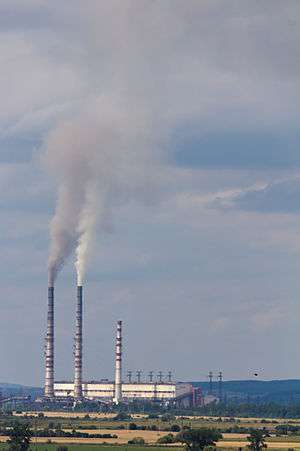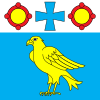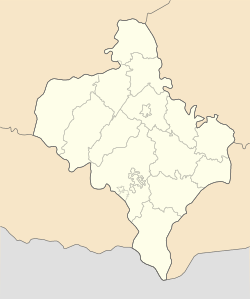Burshtyn
Burštýn (Ukrainian: Буршти́н, Polish: Bursztyn, Hebrew: בורשטין) is a city located in Ivano-Frankivsk Oblast, in western Ukraine, to the north of Halych. It was in the Halych Raion until 11 March 2014, when it received the status of city of oblast significance. It is accessible by rail. It developed rapidly and significantly grew in population during the Soviet period. Administratively, Burshtyn is incorporated as a city of regional significance.
Burshtyn Бурштин Bursztyn Бурштын | |
|---|---|
 Pipes of Burshtyn TES (coal-fired power station) | |
 Flag  Seal | |
| Etymology: Amber (in Ukrainian and Polish) | |
 Burshtyn  Burshtyn | |
| Coordinates: 49°15′30″N 24°37′40″E | |
| Country | |
| Oblast | |
| Municipality | Burshtyn |
| Population (2016) | |
| • Total | 15,640 |
The town, which was one of the Jewish shtetls, and whose name in Ukrainian and Polish literally means Amber, was only granted city status in 1993 and has a special administrative status in Halych Raion. As an urbanized settlement from 1944 to 1962 it was the main town of the raion. There is an old Roman Catholic Church in the center of the city, which was restored at the beginning of the 21st century.
One of its landmarks is the Burshtyn TES coal-fired power station, which is situated on a reservoir approximately 8 km long and 2 km wide. A fish farm lies on the lake near the district of Bilshivtsi. The town is known for its soccer club Enerhetyk.
History
The first mention of this town was in a Halych history book from 1596, where it was referred to as Nove Selo (New village), although the town establishment dates back to 1554. In 1809, Franz Xaver Mozart, son of Wolfgang A. Mozart, lived in Burshtyn which at that time was part of the Austrian Empire.
There is an old Jewish cemetery in Burshtyn, the only surviving testament of once thriving Jewish community in the city – in 1942 there were 1,700 Jews residing in Burshtyn. German troops entered Burshtyn in July but for a few weeks the Ukrainian militia were in control. During that time, they intiated a pogrom against the Jews with many arrested, beaten, and robbed. Some Jewish leaders were gathered in the synagogue where they were humiliated, beaten, and had their beards shown. Ukrainians drank and celebrated throughout the night, while Jews were beaten on the street and their properties looted. When the Germans took control, they established a ghetto and conscripted Jews for forced labor in the twon and elswhere. Jews were rounded up in September and October 1942. Many were killed in the town by German security services and Ukrainian auxiliary police. Most were sent to Belzec where they were immediately murdered or to the Rohatyn ghetto where they were later murdered or sent on to Belzec.[1]
The Jewish cemetery was established in the 18th century with the last known Hasidic Jewish burial in the 1940s.
Notable residents
- Mika Newton, Ukrainian pop singer and Eurovision participant
- Zdzislaw Adamczyk (1886-1940) – Colonel of the Polish Army, mayor of Zakopane, murdered by the NKVD in the Katyn massacre
- Ludwik Finkel – Polish historian, rector of the Lwow University
- Franz Xaver Wolfgang Mozart, Austrian composer lived in the town in 1809
Gallery
- The old Jewish cemetery in Burshtyn
- Burshtyn railway station
 Cathedral in Burshtyn
Cathedral in Burshtyn
See also
References
- Megargee, Geoffrey (2012). Encyclopedia of Camps and Ghettos. Bloomington, Indiana: University of Indiana Press. p. Volume II 766-768. ISBN 978-0-253-35599-7.
Further reading
- Weiner, Miriam; Ukrainian State Archives (in cooperation with); Moldovan National Archives (in cooperation with) (1999). "Chapter 11: Town Clips: Burshtyn". Jewish Roots in Ukraine and Moldova: Pages from the Past and Archival Inventories (PDF). Secaucus, NJ: Miriam Weiner Routes to Roots Foundation. p. 407. ISBN 978-0-96-565081-6. OCLC 607423469.
External links
| Wikimedia Commons has media related to Burshtyn. |